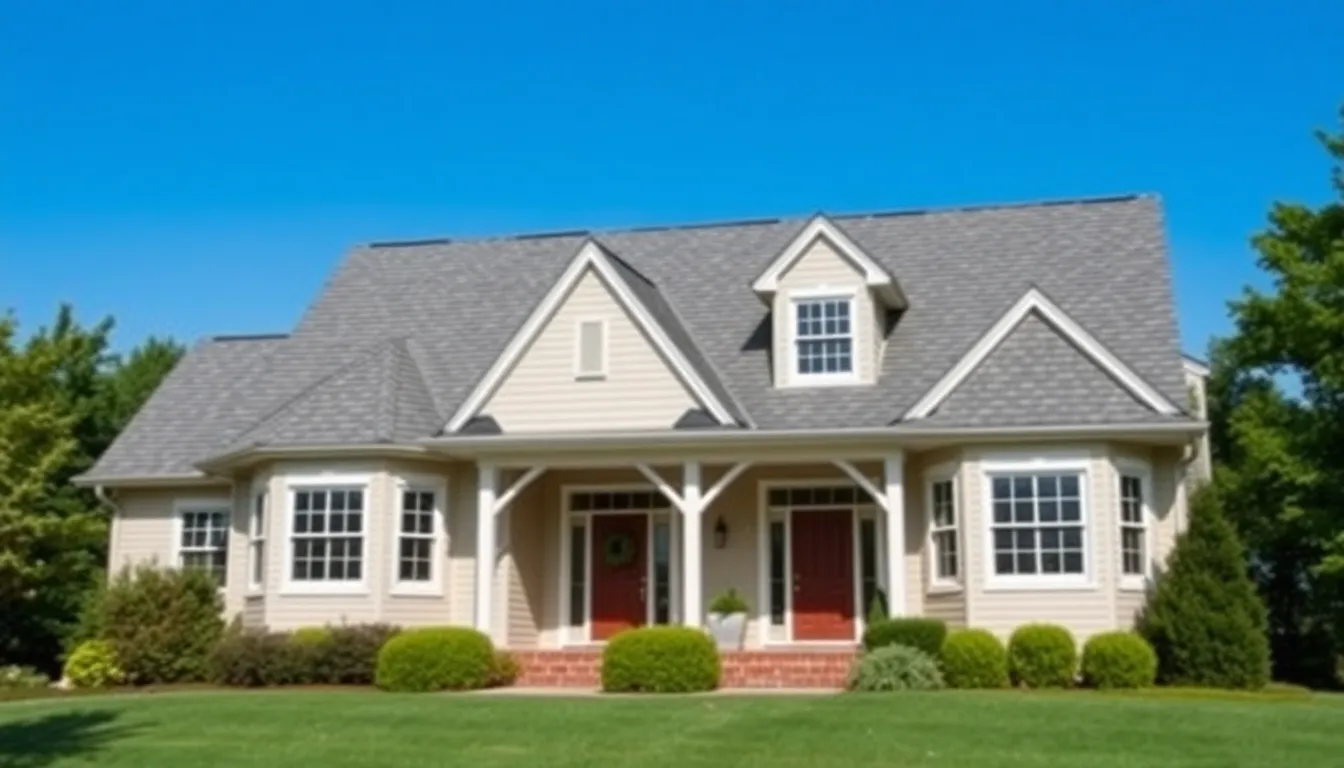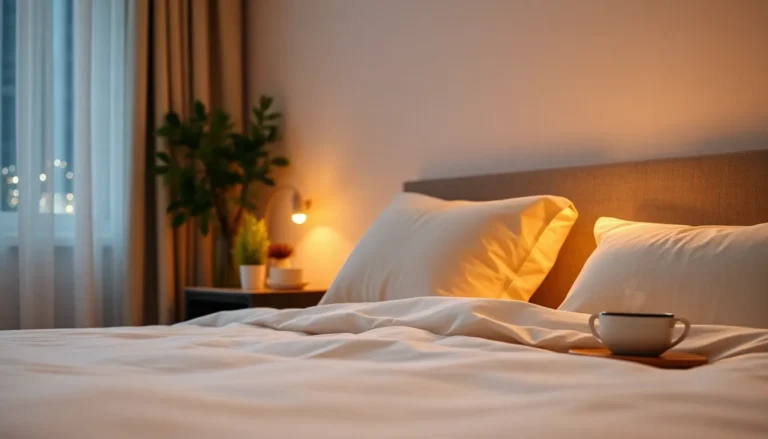When it comes to roofing, the pitch angle can make or break your home’s aesthetic and functionality. Enter the 4/12 pitch angle—a sweet spot that balances style and practicality like peanut butter and jelly. With a rise of 4 inches for every 12 inches of run, this angle isn’t just a number; it’s a game-changer in the world of sloped roofs.
Table of Contents
ToggleOverview of 4/12 Pitch Angle
The 4/12 pitch angle defines a roof slope where the elevation rises 4 inches for every 12 inches of horizontal distance. This angle often strikes a harmonious balance between aesthetics and functionality, making it a popular choice for residential structures. Engineers and architects value this pitch for its ability to effectively shed water, reducing risks associated with water pooling and ensuring longevity.
Homeowners typically appreciate the visual appeal of a 4/12 pitch, as it offers a classic, inviting look that complements various architectural styles. Many prefer this design for its suitability in regions with variable climates, where a moderate slope accommodates snow and rain runoff without compromising structural integrity.
Practically, this pitch angle provides enhanced ventilation capacity. Air can circulate efficiently beneath the roofing material, reducing the buildup of heat and moisture. Roofers find that this pitch allows for easier installation of roofing materials, simplifying maintenance and repair processes.
In terms of insulation, a 4/12 pitch facilitates effective energy efficiency. Roofs with this slope allow for optimal attic spaces, promoting better insulation installation and contributing to overall energy savings. Home value often increases with a well-constructed roof, making this pitch an appealing investment for future homeowners.
Understanding this pitch angle’s various benefits aids in making informed decisions when selecting roofing options. Many professionals recommend it for its versatile application and reliable performance.
Importance of Roof Pitch

Roof pitch plays a vital role in architectural design and functionality, with the 4/12 pitch angle providing distinct advantages.
Structural Integrity
Structural integrity benefits significantly from the 4/12 pitch angle. This angle effectively redirects water away from the roof surface, preventing pooling and potential structural damage. A 4/12 pitch enhances the roof’s strength, distributing weight evenly across supporting beams and rafters. When properly constructed, this pitch supports various roofing materials, including asphalt shingles, metal panels, and tiles. Increased durability reduces risks associated with severe weather conditions, such as heavy rain or snow accumulation. Furthermore, contractors often recommend this pitch for its ability to withstand lateral forces, preventing leaks and extending the roof’s lifespan.
Aesthetic Appeal
Aesthetic appeal remains a key reason homeowners choose the 4/12 pitch angle. This pitch creates an inviting, classic look that complements many architectural styles, from traditional to contemporary. Visual balance enhances curb appeal, increasing property value. Rooflines at a 4/12 pitch promote symmetry and structure, integrating harmoniously with neighboring homes. Versatile in design, this angle accepts various roofing materials, adding texture and depth to the home’s exterior. Customization with features like skylights or dormers becomes simpler, allowing for personalized touches that elevate the overall aesthetic.
Common Applications of 4/12 Pitch Angle
The 4/12 pitch angle finds extensive use in both residential and commercial contexts due to its blend of functionality and visual appeal.
Residential Buildings
Homeowners frequently choose the 4/12 pitch angle for their residences. This angle suits a variety of architectural styles, from traditional to modern. It efficiently sheds water, minimizing the risk of leaks and water pooling. Energy efficiency receives a boost due to improved ventilation, which helps regulate temperature and reduce heating and cooling costs. Additionally, the classic look enhances property value, attracting buyers with its inviting aesthetic. Customization options, such as skylights and dormers, also increase its appeal for residential designs.
Commercial Structures
Businesses rely on the 4/12 pitch angle for practical and aesthetic benefits. This pitch effectively channels rainwater, preserving the integrity of the building and reducing maintenance costs. Visibility plays a crucial role; roofs with this pitch create a visually appealing silhouette against the skyline. Durability stands out, as this angle can withstand severe weather conditions, ensuring long-term stability. Moreover, it provides ample space for ventilation systems, essential for a comfortable work environment. With such versatility, the 4/12 pitch angle remains a preferred choice for various commercial developments.
Benefits of Choosing a 4/12 Pitch Angle
Choosing a 4/12 pitch angle offers several distinct advantages that enhance both functionality and appearance.
Drainage Efficiency
The 4/12 pitch angle excels in drainage efficiency. A rise of 4 inches for every 12 inches of run allows for optimal water runoff. This design minimizes the likelihood of water pooling, which can lead to leaks and structural damage over time. Effective water shedding contributes to the longevity of the roofing system, ensuring that it remains durable even in harsh weather. Homeowners observing heavy rainfall benefit significantly from this angle, as it efficiently channels water away from the roof and foundation. Overall, selecting a 4/12 pitch promotes a reliable drainage system that elevates roof performance.
Versatile Design Options
Versatility defines the design options available with a 4/12 pitch angle. This architectural choice complements a myriad of styles, from traditional homes to modern structures. Homeowners often appreciate how the 4/12 pitch seamlessly accommodates features like skylights, dormers, and gables, enhancing aesthetic appeal. Various roofing materials marry well with this angle, enabling customization that suits personal tastes. Curb appeal flourishes due to the balance this pitch strikes between function and style. As such, this adaptability allows for creative solutions that enhance the vision of any building project.
Potential Drawbacks
While the 4/12 pitch angle offers various benefits, some potential drawbacks exist.
Snow Accumulation
Snow accumulation may pose challenges for roofs with a 4/12 pitch angle. The moderate slope can allow snow to build up, especially in regions with heavy snowfall. Roofs with steeper angles tend to shed snow more effectively. Consequently, homeowners may face increased snow load on structures, increasing the risk of damage or collapse. Problems like ice dam formation can also occur, hindering drainage and leading to potential leaks. Inspections and maintenance become crucial to ensure the roof remains safe and functional in winter months.
Limited Space
Limited space for attic use is another consideration with the 4/12 pitch angle. The sloped design reduces vertical space, potentially limiting storage or living area options in the attic. Homeowners seeking to create usable attic areas may find the lower height restrictive. Custom modifications, like raised ceilings, could effectively address space challenges. Still, these solutions often involve additional costs and planning. Homeowners must weigh the need for aesthetics and functionality when determining if this pitch suits their needs.
The 4/12 pitch angle stands out as a practical and aesthetically pleasing choice for both residential and commercial roofing. Its effective water shedding capabilities and structural integrity make it a reliable option for various climates. Homeowners benefit from its classic look while enjoying enhanced ventilation and energy efficiency.
However it’s essential to consider potential challenges like snow accumulation and limited attic space. Weighing these factors allows homeowners to make informed decisions that suit their specific needs. Ultimately the 4/12 pitch angle remains a versatile option that balances beauty and functionality, ensuring lasting value for any property.



